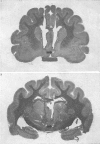Abstract
1. Isolated regions of the anterior, posterior and other areas of the hypothalamus of the unanaesthetized cat were perfused by means of push-pull cannulae lowered through permanently implanted guide tubes. Each site was perfused for a 30 min interval at a rate of 50 μl./min. Concentrations of sodium, calcium, potassium and magnesium ions in the perfusate were altered selectively.
2. Sodium ions in a concentration which varied from 13·6 to 68·0 mM in excess of the level in extracellular fluid caused a steep rise in the temperature of the cat when the solution was perfused at sites located within the posterior hypothalamic area. Shivering, vasoconstriction, and piloerection accompanied the increase in temperature. When the chloride was replaced in the perfusate by the toluene-p-sulphonate salt of sodium, the hyperthermia was equally intense. Solutions containing excess sodium ions perfused within the anterior and other hypothalamic areas produced either a slight fall or rise in temperature as well as other physiological changes.
3. Calcium ions in a concentration which varied from 2·6 to 10·4 mM in excess of the physiological level perfused at the same sites within the posterior region of the hypothalamus produced a sharp fall in body temperature, which was accompanied by vasodilatation and a decrease in the activity of the cat. When solutions containing excess calcium were perfused in the anterior and other hypothalamic areas, no consistent change in temperature occurred.
4. Potassium or magnesium ions in concentrations which varied from two to ten times the level in extracellular fluid had virtually no effect on the temperature of the cat when they were perfused in the anterior, posterior or other areas of the hypothalamus.
5. We conclude that the constancy in the ratio between sodium and calcium ions in the posterior hypothalamus may be the inherent mechanism by which the set-point for body temperature is determined.
Full text
PDF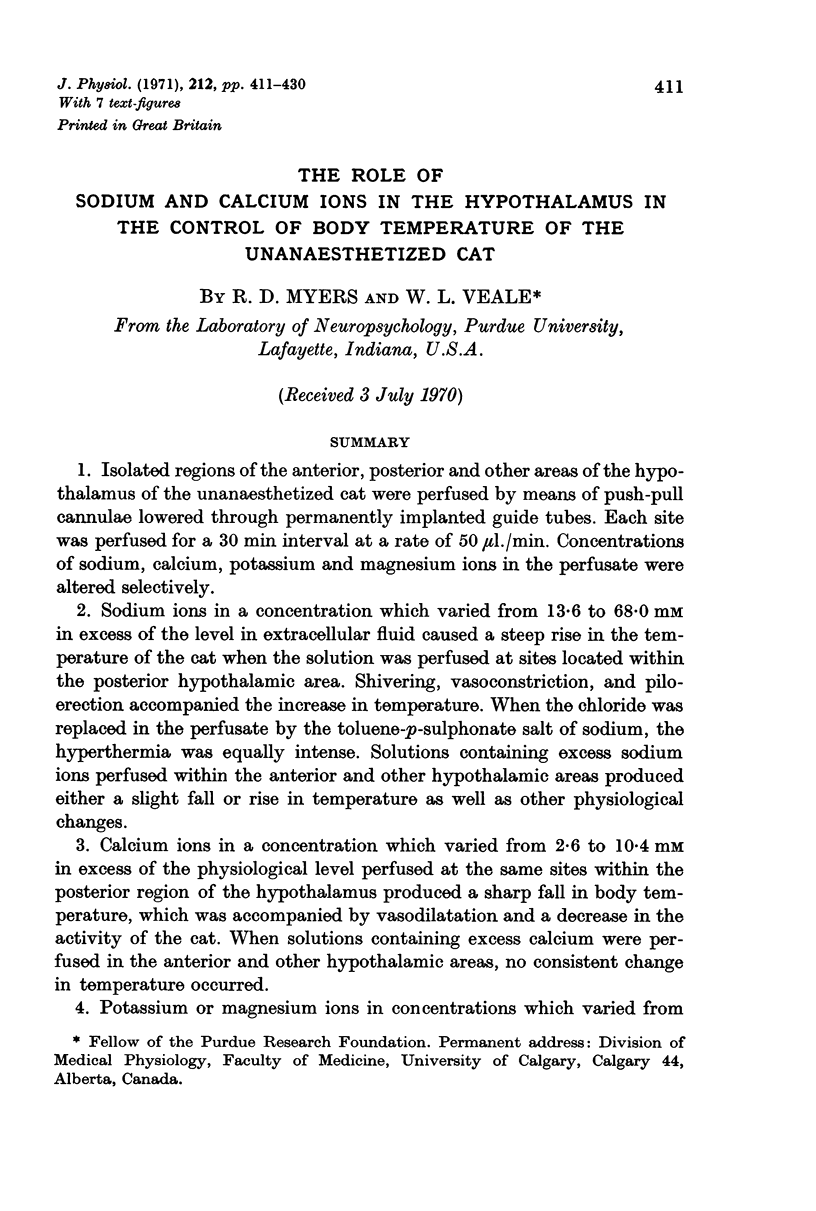
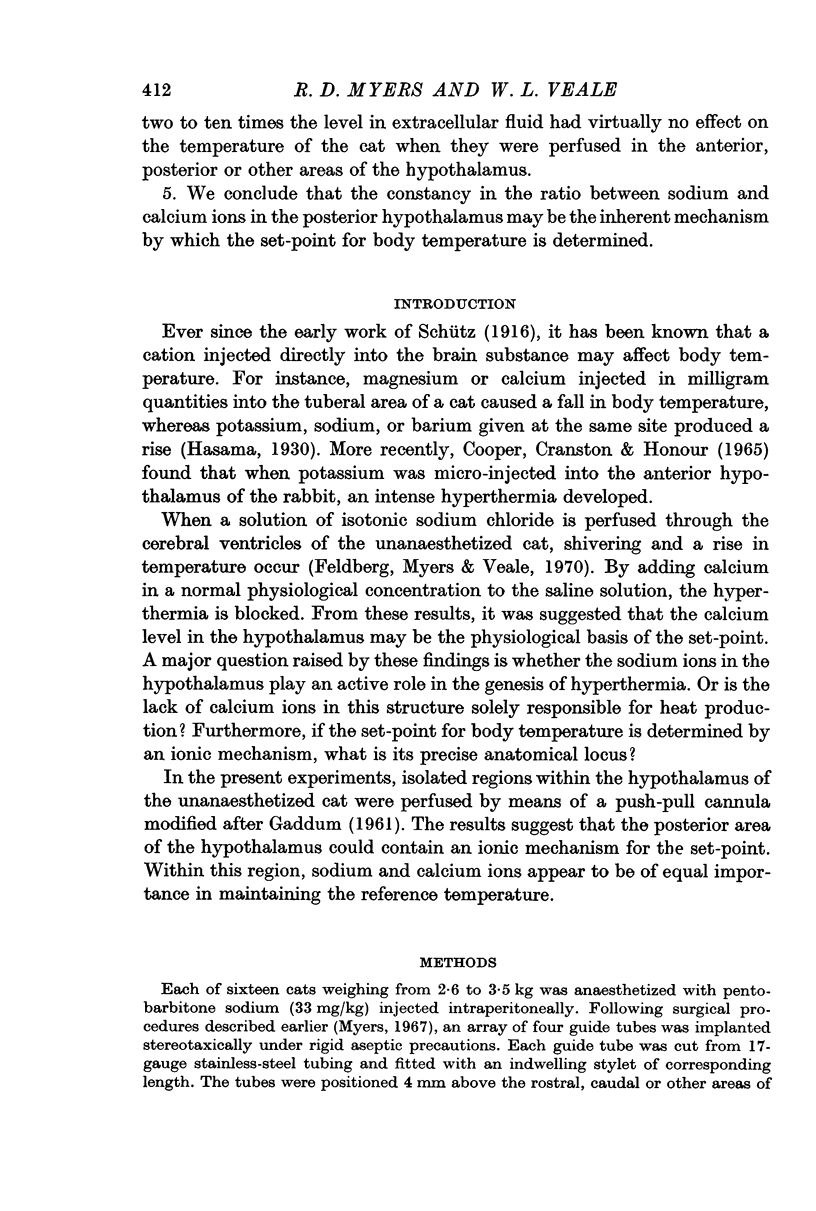
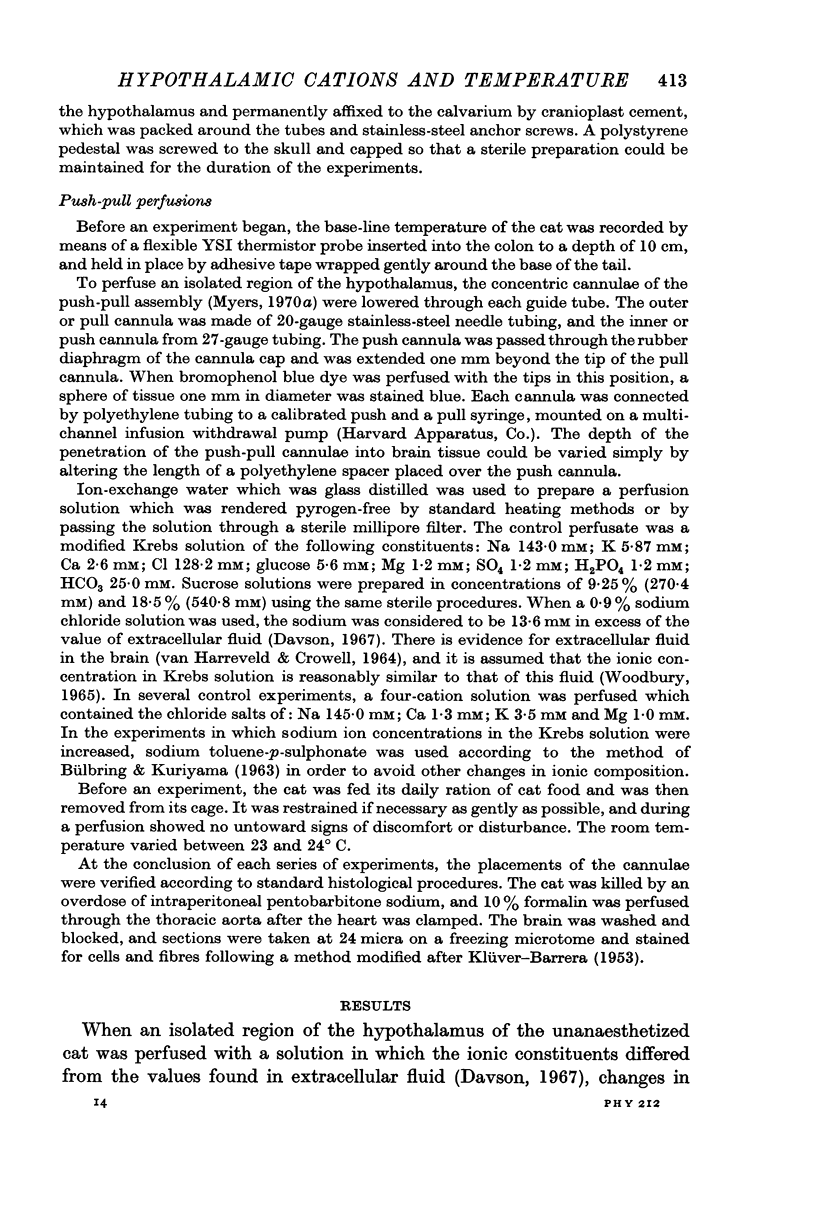
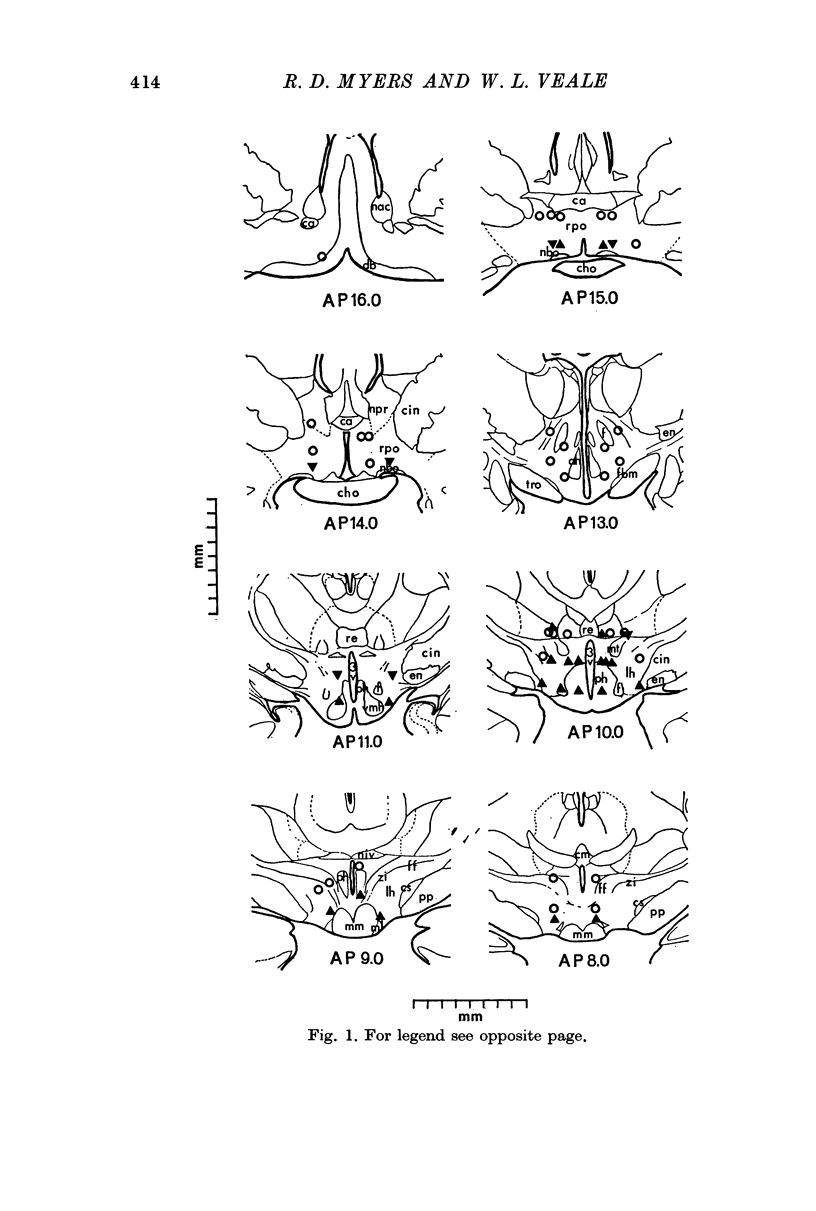
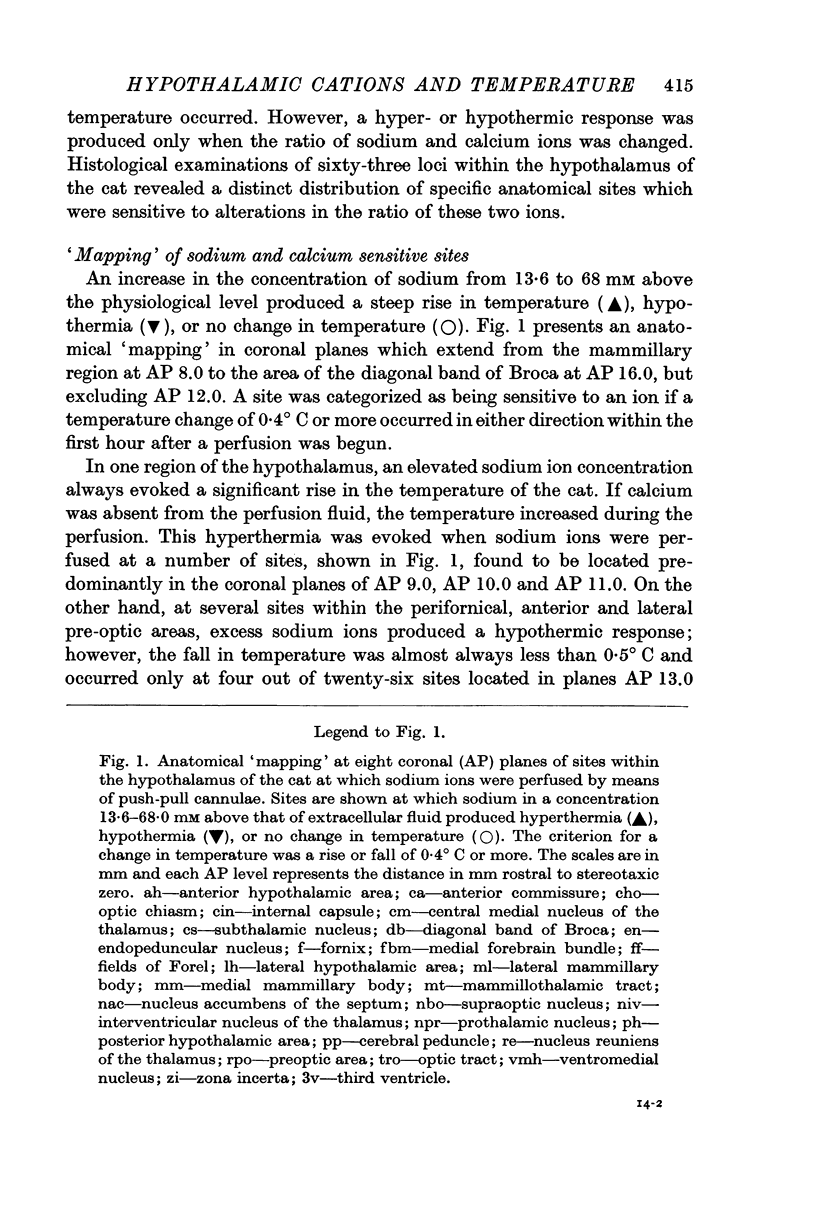
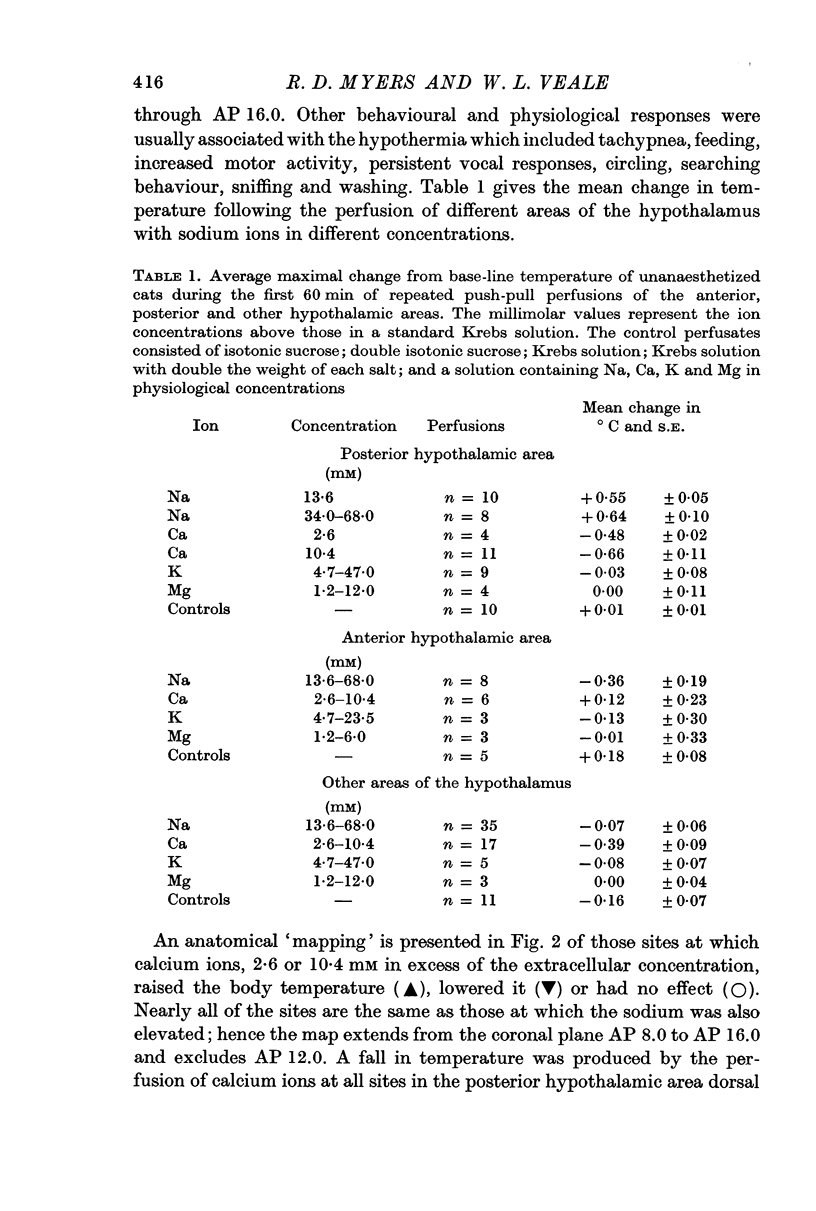
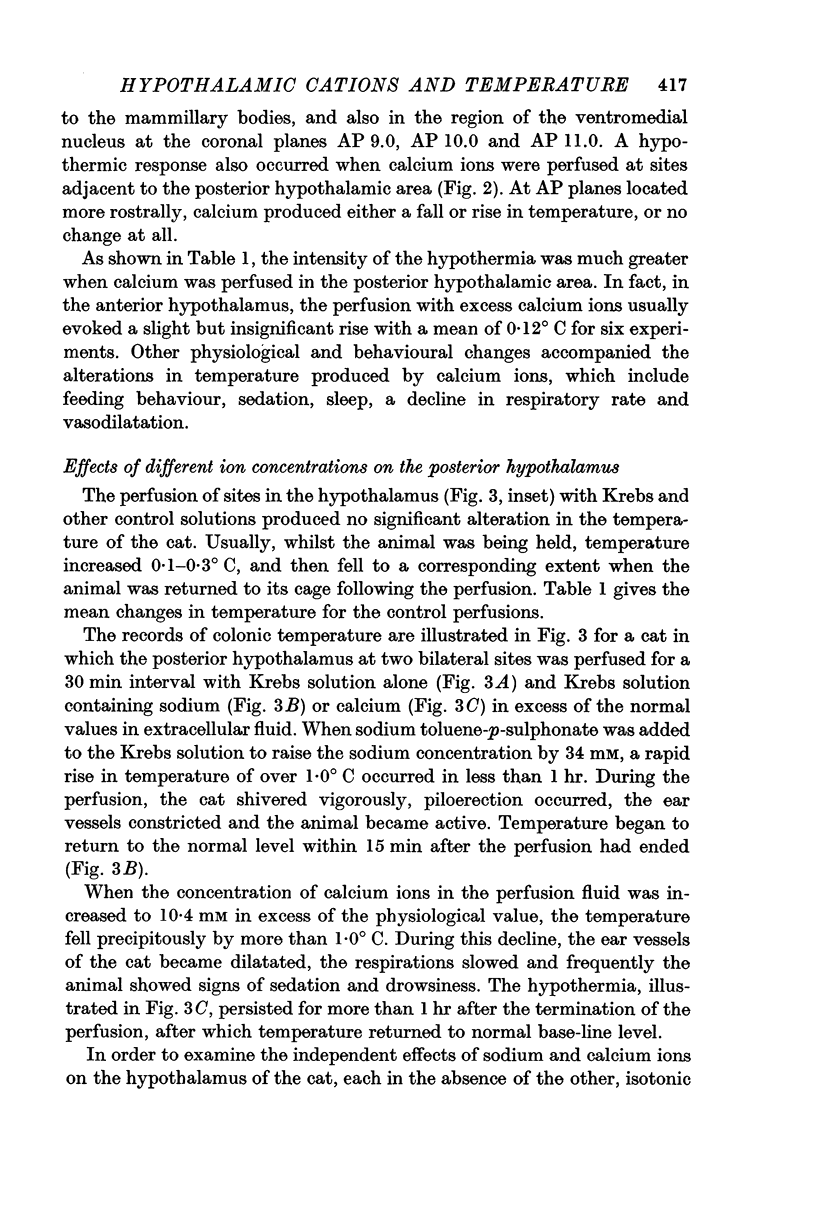
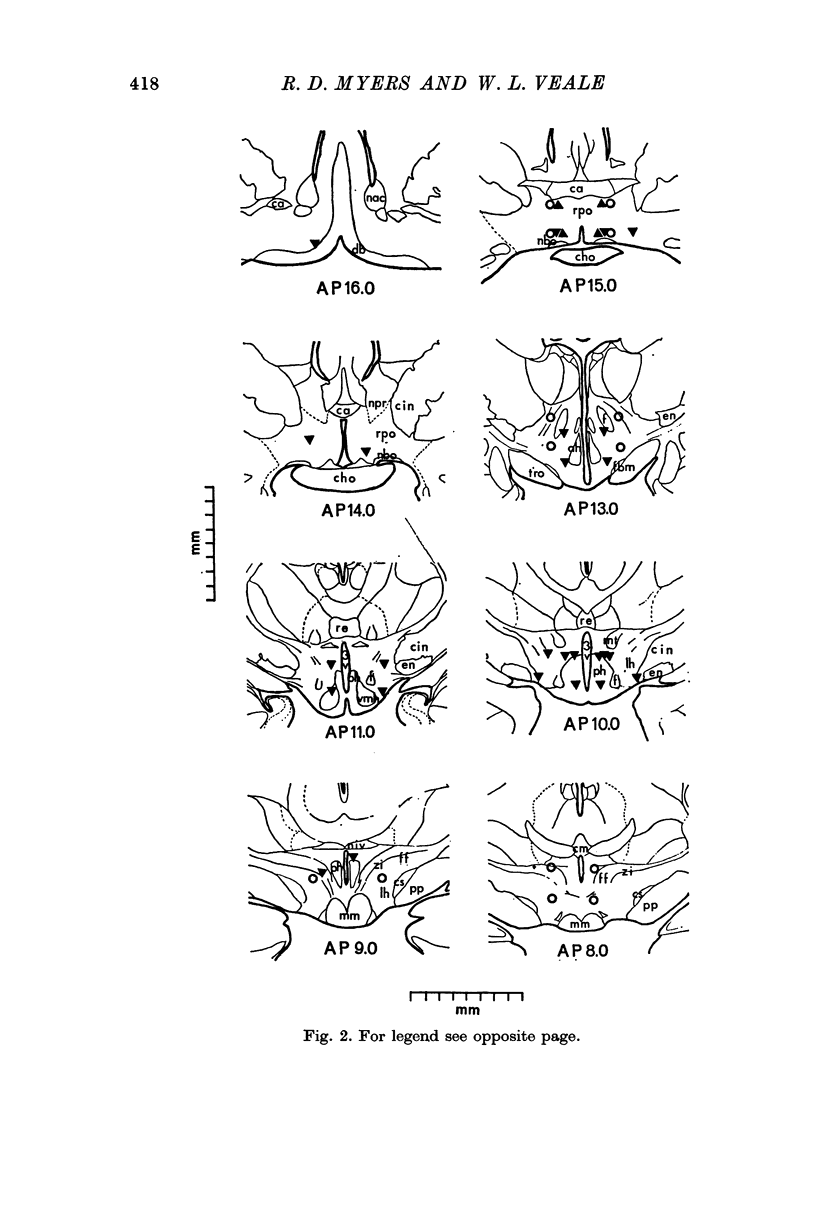
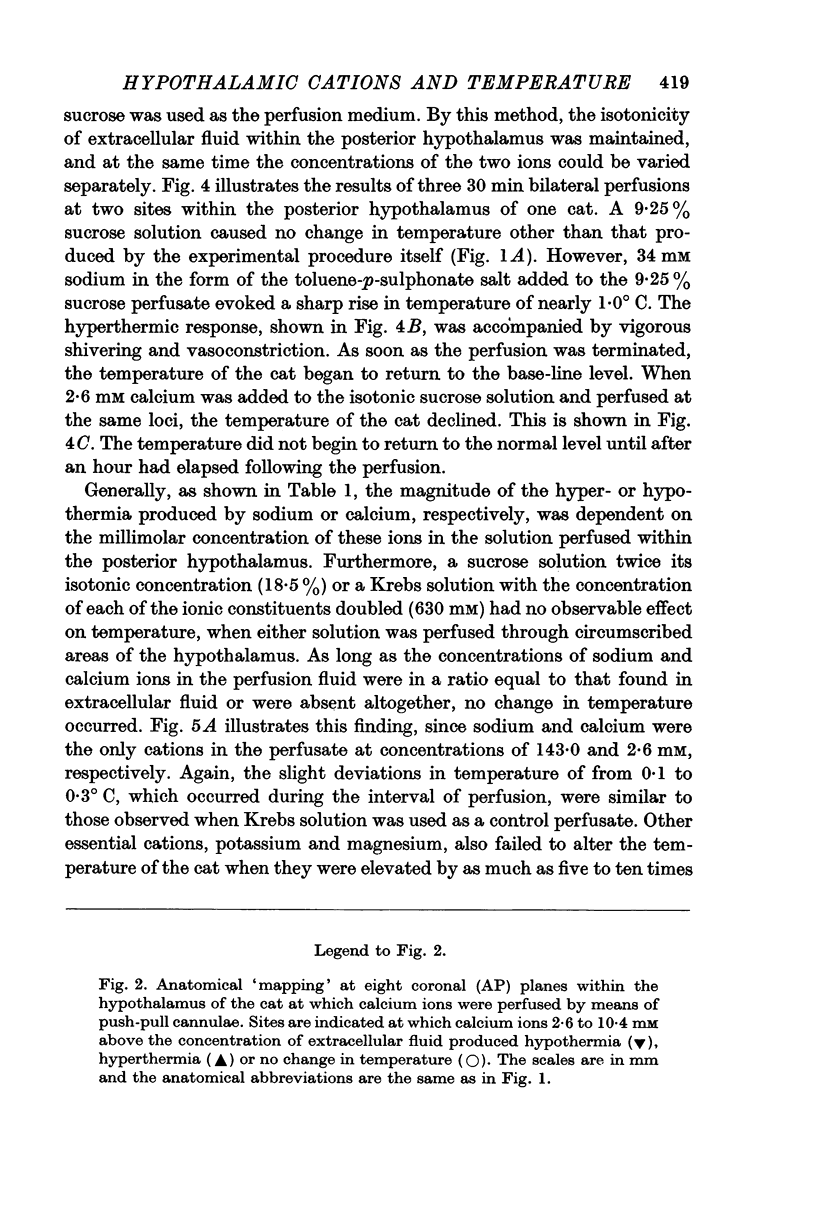
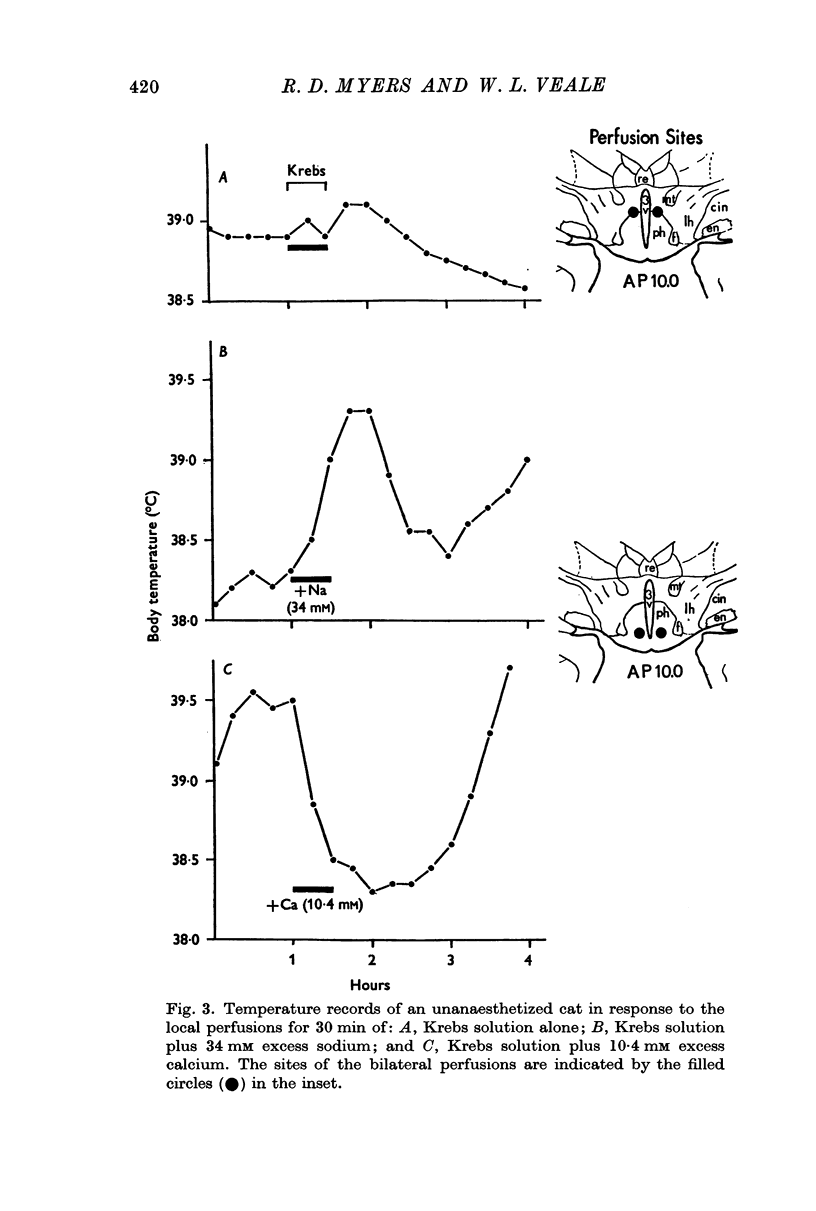
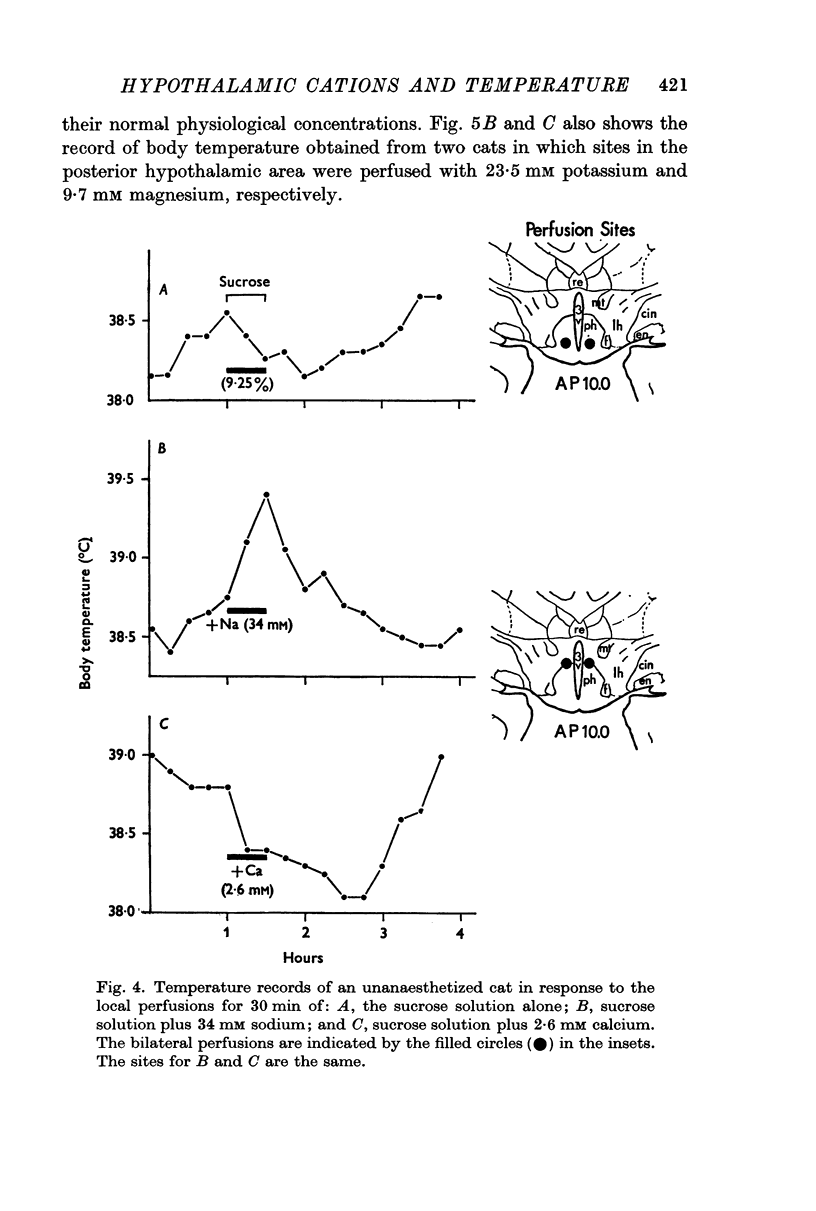
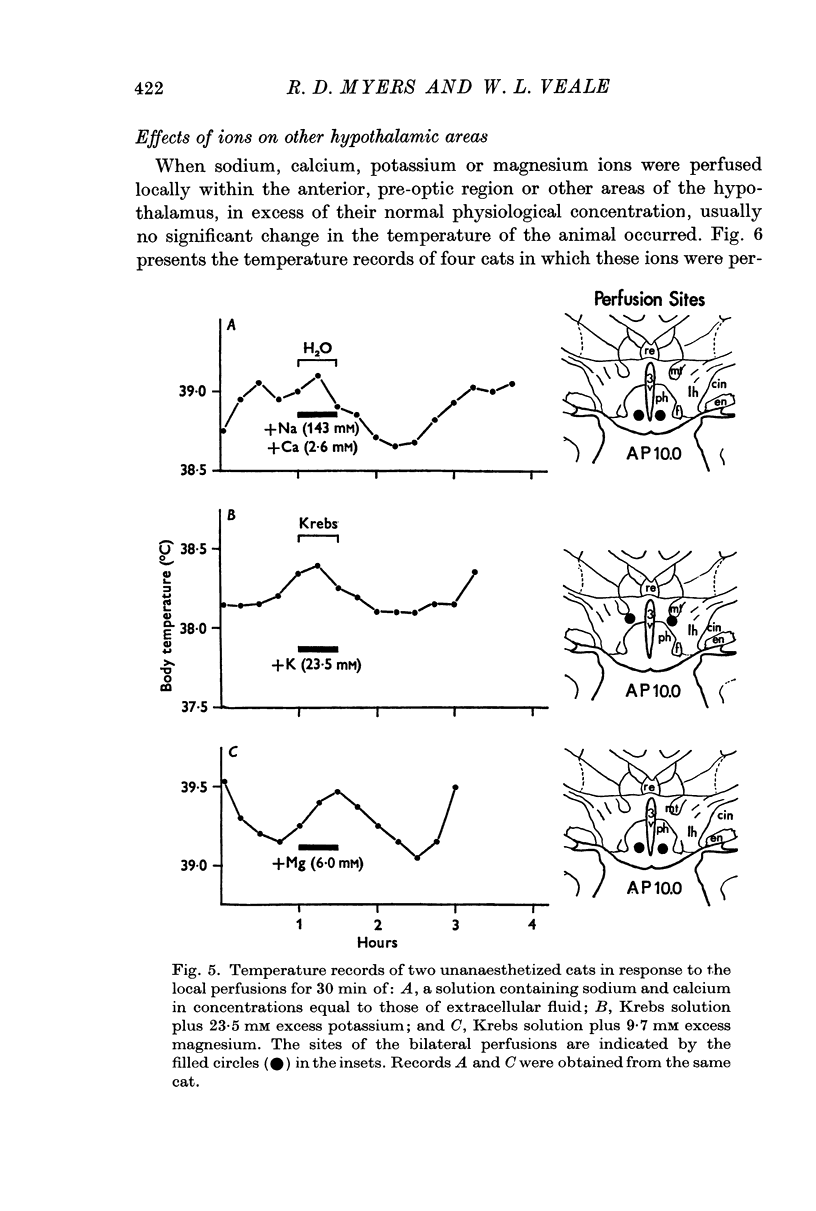
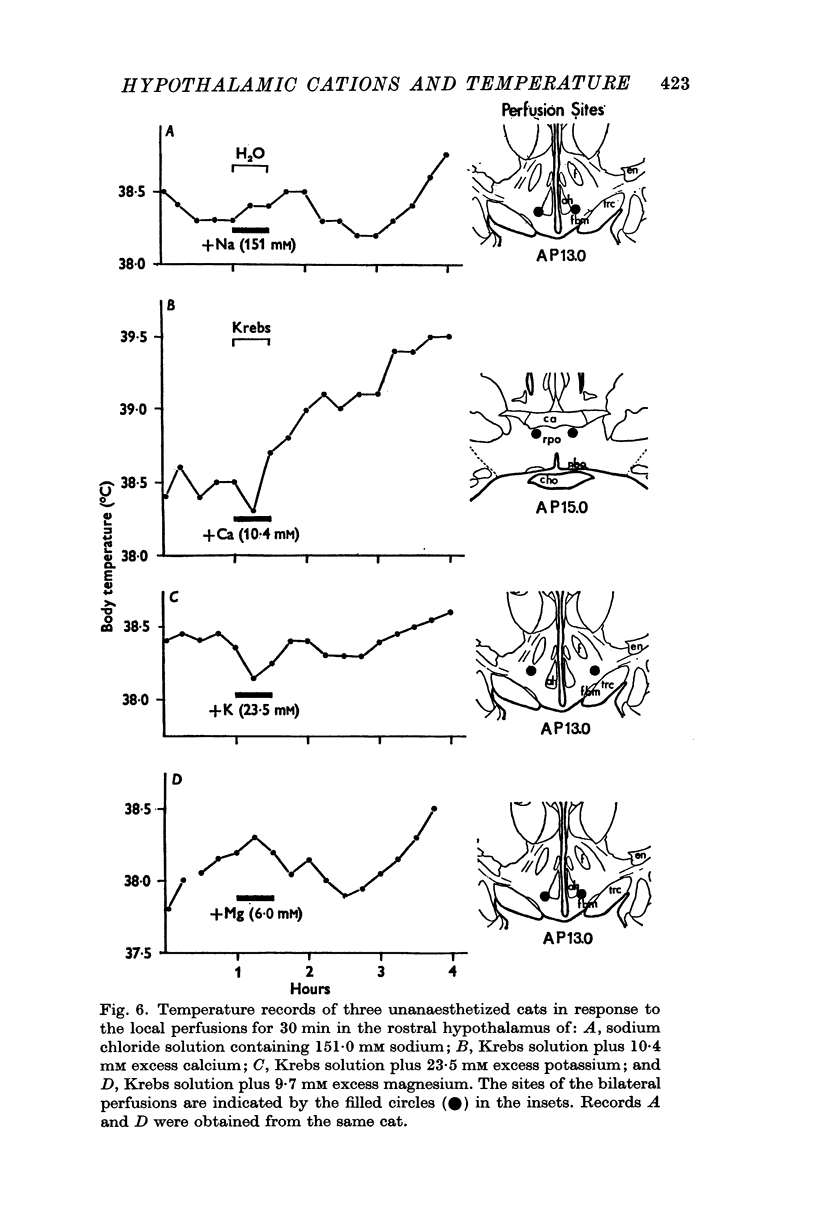
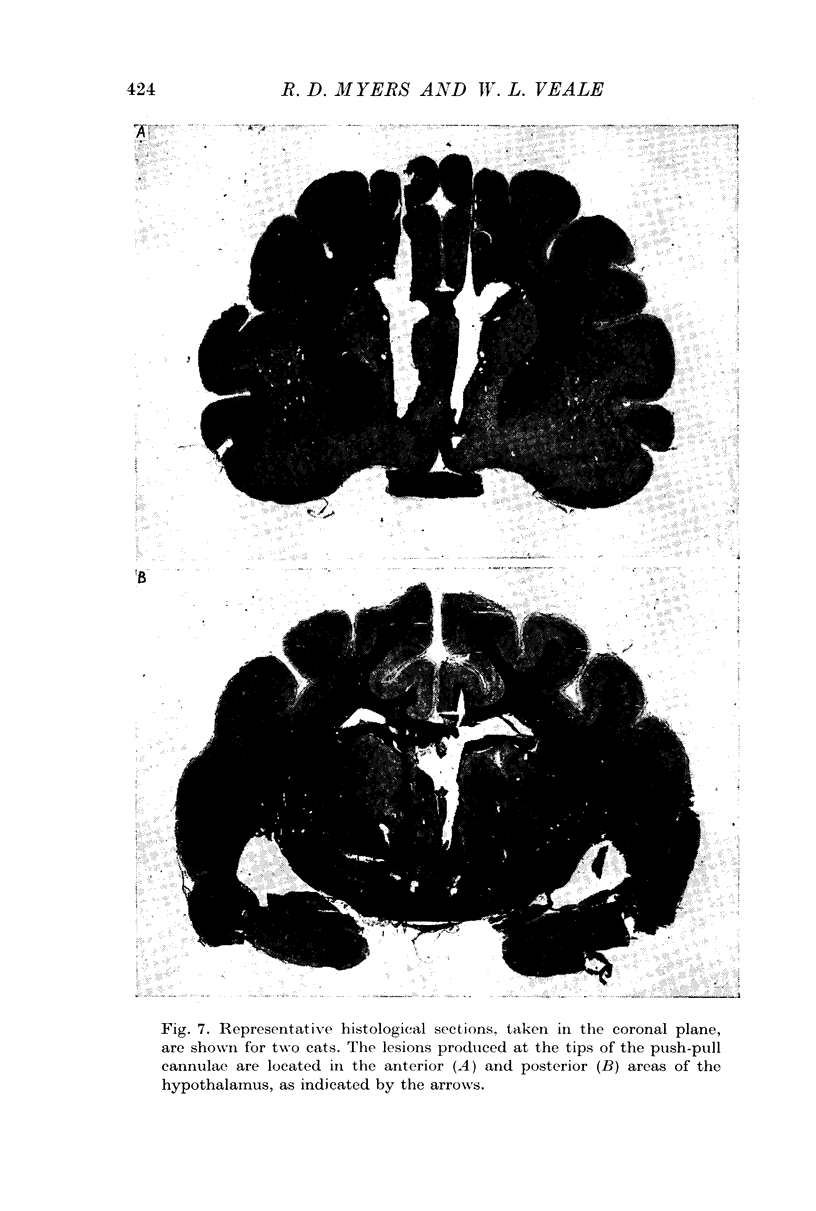
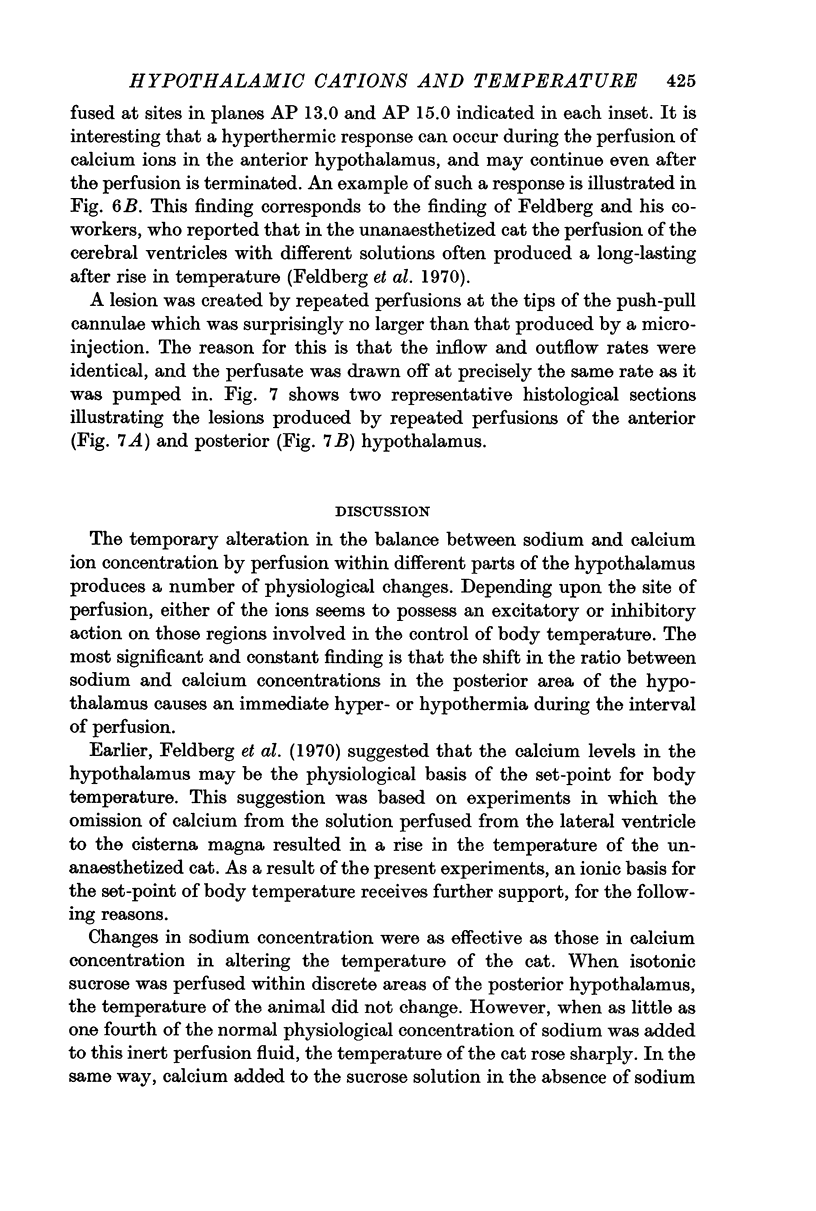
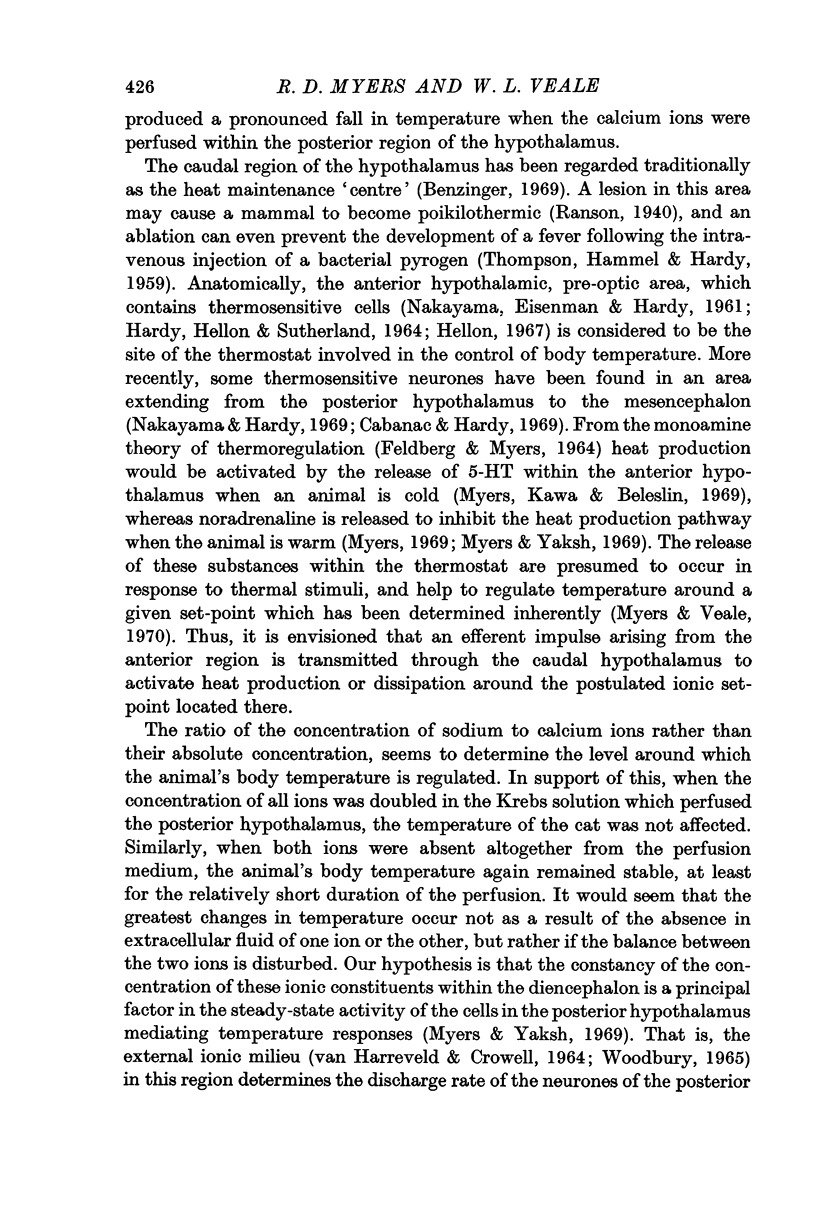
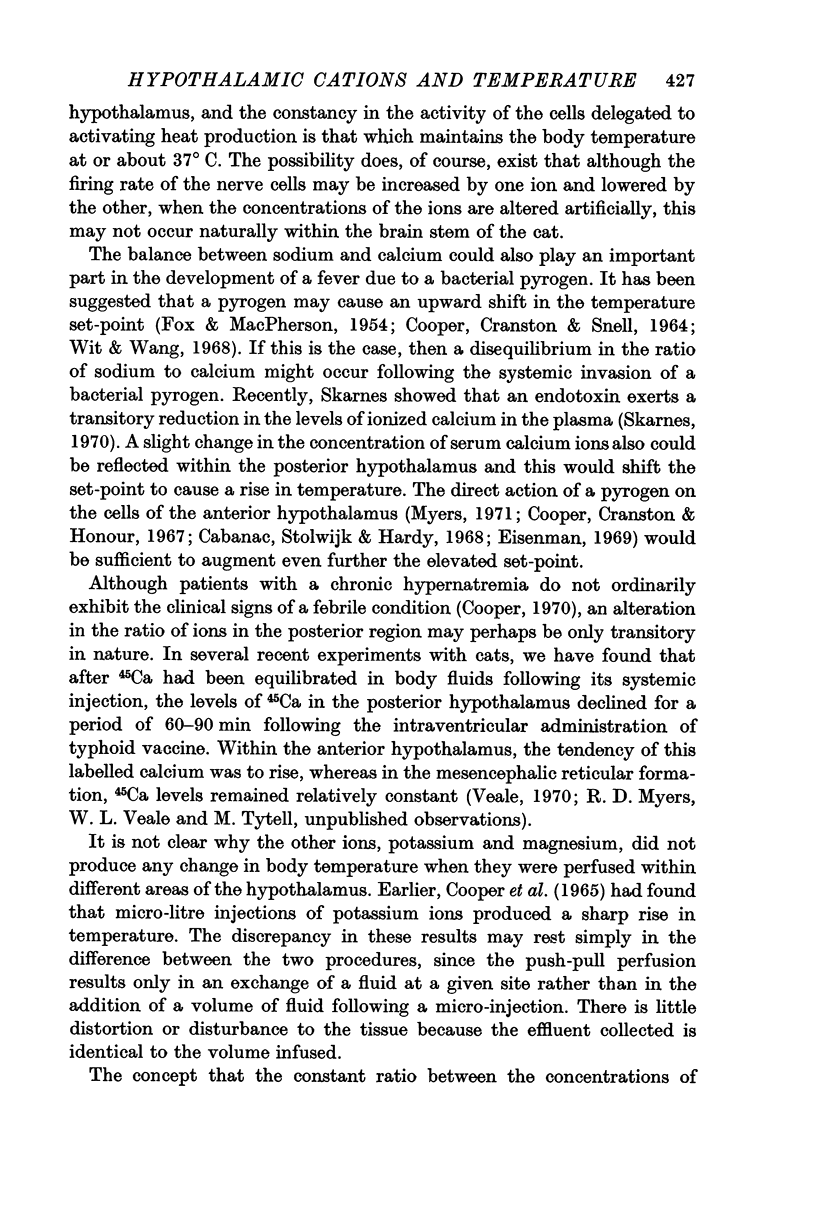
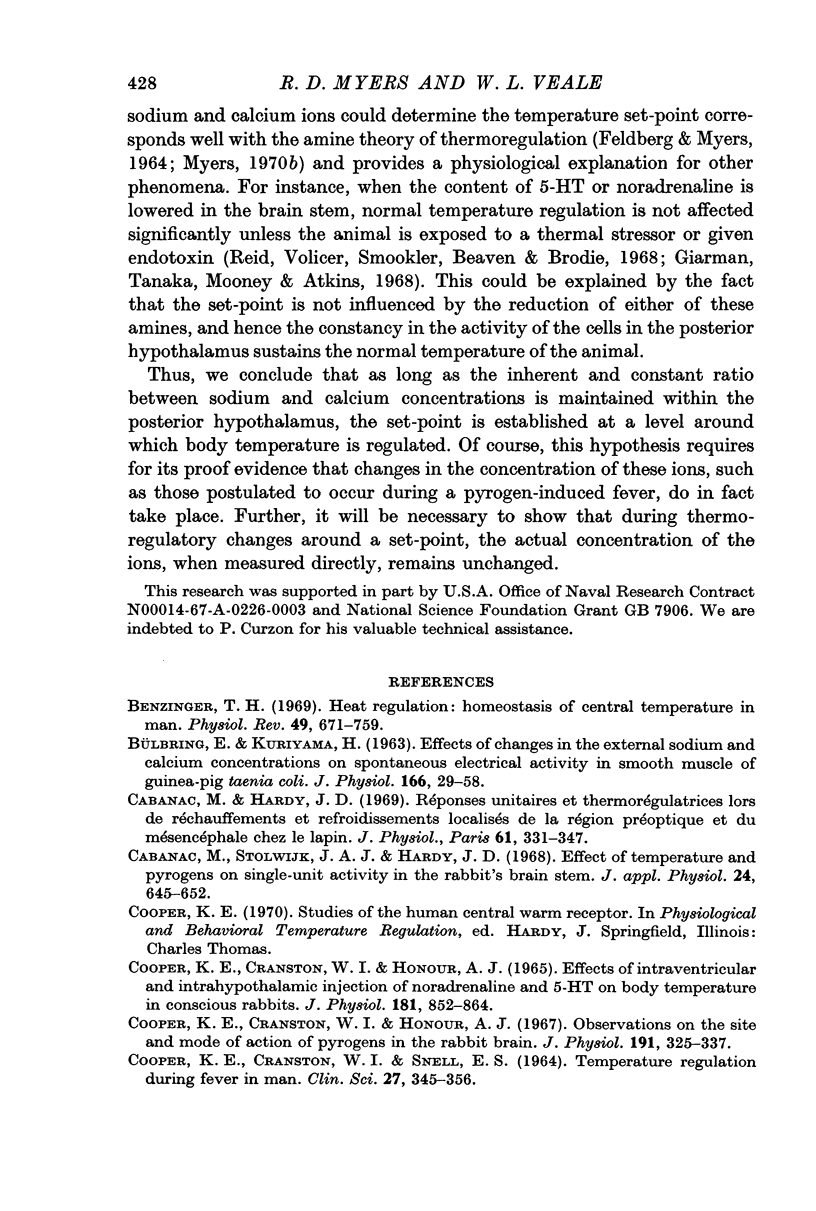
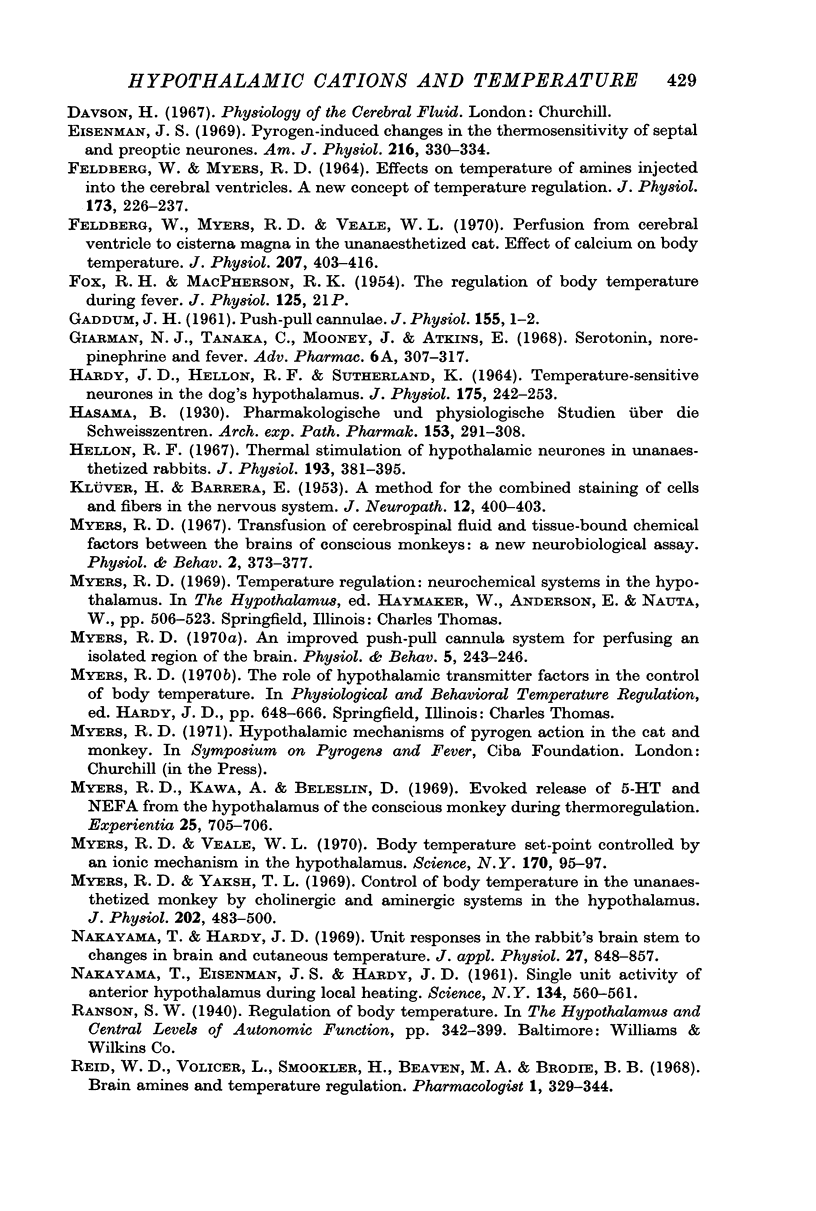
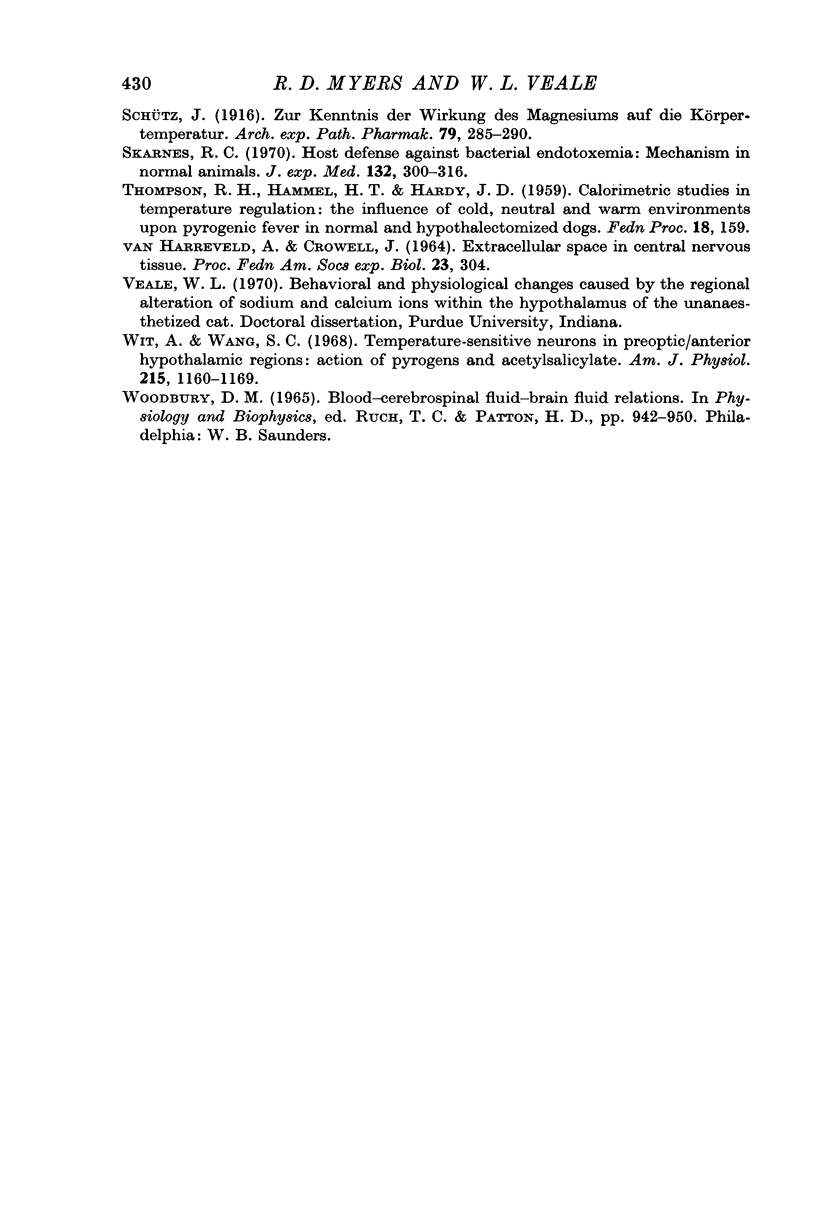
Images in this article
Selected References
These references are in PubMed. This may not be the complete list of references from this article.
- BULBRING E., KURIYAMA H. Effects of changes in the external sodium and calcium concentrations on spontaneous electrical activity in smooth muscle of guinea-pig taenia coli. J Physiol. 1963 Apr;166:29–58. doi: 10.1113/jphysiol.1963.sp007089. [DOI] [PMC free article] [PubMed] [Google Scholar]
- Benzinger T. H. Heat regulation: homeostasis of central temperature in man. Physiol Rev. 1969 Oct;49(4):671–759. doi: 10.1152/physrev.1969.49.4.671. [DOI] [PubMed] [Google Scholar]
- COOPER K. E., CRANSTON W. I., SNELL E. S. TEMPERATURE REGULATION DURING FEVER IN MAN. Clin Sci. 1964 Dec;27:345–356. [PubMed] [Google Scholar]
- Cabanac M., Hardy J. D. Réponses unitaires et thermorégulatrices lors de réchauffements et refroidissements localisés de la région préoptique et du mésencéphale chez le lapin. J Physiol (Paris) 1969 Jul-Aug;61(4):331–347. [PubMed] [Google Scholar]
- Cabanac M., Stolwijk J. A., Hardy J. D. Effect of temperature and pyrogens on single-unit activity in the rabbit's brain stem. J Appl Physiol. 1968 May;24(5):645–652. doi: 10.1152/jappl.1968.24.5.645. [DOI] [PubMed] [Google Scholar]
- Cooper K. E., Cranston W. I., Honour A. J. Effects of intraventricular and intrahypothalamic injection of noradrenaline and 5-HT on body temperature in conscious rabbits. J Physiol. 1965 Dec;181(4):852–864. doi: 10.1113/jphysiol.1965.sp007801. [DOI] [PMC free article] [PubMed] [Google Scholar]
- Cooper K. E., Cranston W. I., Honour A. J. Observations on the site & mode of action of pyrogens in the rabbit brain. J Physiol. 1967 Jul;191(2):325–337. doi: 10.1113/jphysiol.1967.sp008253. [DOI] [PMC free article] [PubMed] [Google Scholar]
- Eisenman J. S. Pyrogen-induced changes in the thermosensitivity of septal and preoptic neurons. Am J Physiol. 1969 Feb;216(2):330–334. doi: 10.1152/ajplegacy.1969.216.2.330. [DOI] [PubMed] [Google Scholar]
- FELDBERG W., MYERS R. D. EFFECTS ON TEMPERATURE OF AMINES INJECTED INTO THE CEREBRAL VENTRICLES. A NEW CONCEPT OF TEMPERATURE REGULATION. J Physiol. 1964 Sep;173:226–231. doi: 10.1113/jphysiol.1964.sp007454. [DOI] [PMC free article] [PubMed] [Google Scholar]
- FOX R. H., MACPHERSON R. K. The regulation of body temperature during fever. J Physiol. 1954 Jul 28;125(1):21–2P. [PubMed] [Google Scholar]
- Feldberg W., Myers R. D., Veale W. L. Perfusion from cerebral ventricle to cisterna magna in the unanaesthetized cat. Effect of calcium on body temperature. J Physiol. 1970 Apr;207(2):403–416. doi: 10.1113/jphysiol.1970.sp009069. [DOI] [PMC free article] [PubMed] [Google Scholar]
- Giarman N. J., Tanaka C., Mooney J., Atkins E. Serotonin, norepinephrine, and fever. Adv Pharmacol. 1968;6(Pt A):307–317. doi: 10.1016/s1054-3589(08)61186-2. [DOI] [PubMed] [Google Scholar]
- HARDY J. D., HELLON R. F., SUTHERLAND K. TEMPERATURE-SENSITIVE NEURONES IN THE DOG'S HYPOTHALAMUS. J Physiol. 1964 Dec;175:242–253. doi: 10.1113/jphysiol.1964.sp007515. [DOI] [PMC free article] [PubMed] [Google Scholar]
- Hellon R. F. Thermal stimulation of hypothalamic neurones in unanaesthetized rabbits. J Physiol. 1967 Nov;193(2):381–395. doi: 10.1113/jphysiol.1967.sp008364. [DOI] [PMC free article] [PubMed] [Google Scholar]
- KLUVER H., BARRERA E. A method for the combined staining of cells and fibers in the nervous system. J Neuropathol Exp Neurol. 1953 Oct;12(4):400–403. doi: 10.1097/00005072-195312040-00008. [DOI] [PubMed] [Google Scholar]
- MARLEY E., PATON W. D. The output of sympathetic amines from the cat's adrenal gland in response to splanchnic nerve activity. J Physiol. 1961 Jan;155:1–27. doi: 10.1113/jphysiol.1961.sp006610. [DOI] [PMC free article] [PubMed] [Google Scholar]
- Myers R. D. An improved push-pull cannula system for perfusing an isolated region of the brain. Physiol Behav. 1970 Feb;5(2):243–246. doi: 10.1016/0031-9384(70)90073-9. [DOI] [PubMed] [Google Scholar]
- Myers R. D., Kawa A., Beleslin D. B. Evoked release of 5-HT and NEFA from the hypothalamus of the conscious monkey during thermoregulation. Experientia. 1969;25(7):705–706. doi: 10.1007/BF01897574. [DOI] [PubMed] [Google Scholar]
- Myers R. D., Veale W. L. Body temperature: possible ionic mechanism in the hypothalamus controlling the set point. Science. 1970 Oct 2;170(3953):95–97. doi: 10.1126/science.170.3953.95. [DOI] [PubMed] [Google Scholar]
- Myers R. D., Yaksh T. L. Control of body temperature in the unanaesthetized monkey by cholinergic and aminergic systems in the hypothalamus. J Physiol. 1969 Jun;202(2):483–500. doi: 10.1113/jphysiol.1969.sp008822. [DOI] [PMC free article] [PubMed] [Google Scholar]
- NAKAYAMA T., EISENMAN J. S., HARDY J. D. Single unit activity of anterior hypothalamus during local heating. Science. 1961 Aug 25;134(3478):560–561. doi: 10.1126/science.134.3478.560. [DOI] [PubMed] [Google Scholar]
- Nakayama T., Hardy J. D. Unit responses in the rabbit's brain stem to changes in brain and cutaneous temperature. J Appl Physiol. 1969 Dec;27(6):848–857. doi: 10.1152/jappl.1969.27.6.848. [DOI] [PubMed] [Google Scholar]
- Reid W. D., Volicer L., Smookler H., Beaven M. A., Brodie B. B. Brain amines and temperature regulation. Pharmacology. 1968;1(6):329–344. doi: 10.1159/000135983. [DOI] [PubMed] [Google Scholar]
- Skarnes R. C. Host defense against bacterial endotoxemia: mechanism in normal animals. J Exp Med. 1970 Aug 1;132(2):300–316. doi: 10.1084/jem.132.2.300. [DOI] [PMC free article] [PubMed] [Google Scholar]
- Wit A., Wang S. C. Temperature-sensitive neurons in preoptic-anterior hypothalamic region: actions of pyrogen and acetylsalicylate. Am J Physiol. 1968 Nov;215(5):1160–1169. doi: 10.1152/ajplegacy.1968.215.5.1160. [DOI] [PubMed] [Google Scholar]



